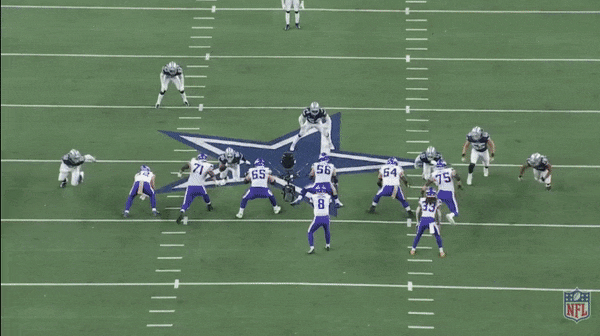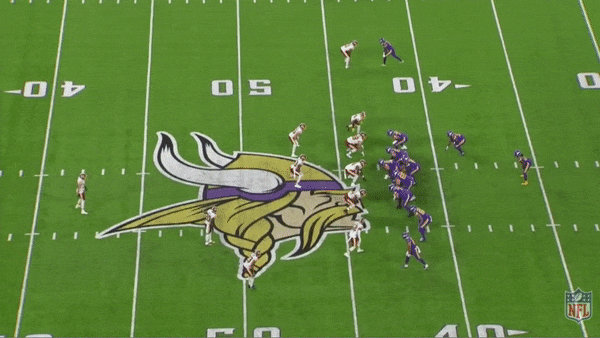It’s only fitting that on the day Stefon Diggs was traded to the Bills, a more famous receiver gobbled up most of the headlines. A few hours before Buffalo sent a first-round pick (and more) to the Vikings on March 16, the Texans had stunned the football world by shipping superstar wideout DeAndre Hopkins to Arizona. It didn’t matter that the deal for Diggs fetched more draft capital, or that the Bills’ bold move had a chance to make them true contenders in the AFC. Hopkins was the story, and yet again, Diggs was overshadowed by one of his pass-catching peers.
In the pecking order of NFL receivers, Diggs rarely gets mentioned alongside guys like Hopkins, Julio Jones, or Michael Thomas. As an undersized former fifth-round pick from an afterthought Maryland program, Diggs doesn’t fit the typical profile of an elite receiver. Hell, many saw him as the second best receiver on the Vikings, after hometown hero Adam Thielen.
His standing in the Minnesota offense was just one of several slights that didn’t seem to sit well with Diggs, and early on last season, it became obvious to those around the Vikings organization that the union between the wideout and the franchise was fraying. He missed practice despite not being listed with an injury, used cryptic emojis in his tweets, and eventually said he was “frustrated” with Minnesota’s 2-2 start. So when the opportunity for a trade with Buffalo arose, the deal seemed to make sense for all parties involved. The Vikings got the draft capital they needed to both replace Diggs (with former LSU receiver Justin Jefferson) and help restock a roster that had been purged this offseason. Diggs is now a team’s undisputed no. 1 target. He’s wiggled free from one of the league’s most run-heavy offenses. And the Bills seemingly have the final piece of an ascending offense, a receiver that will help get both the franchise and its quarterback over that final championship hurdle.
Patience doesn’t come easy for most NFL GMs. The pressure to immediately produce breeds a culture of self-preservation and shortsightedness that can jeopardize a franchise’s timeline and long-term outlook. Brandon Beane, though, has managed to avoid those trappings since being hired as the Bills’ GM in 2017. Aside from an aggressive set of maneuvers to trade up for Josh Allen in the 2018 draft (and to a lesser extent, a move to acquire linebacker Tremaine Edmunds later that night), Beane has eschewed splashy moves in favor of prudent ones.
He and head coach Sean McDermott spent their first year together digging the franchise out of a salary cap quagmire, and even when the Bills were finally armed with excess cap space in 2019, Beane chose to spend his resources on a handful of complementary players. Heading into this offseason, Buffalo had just one player — center Mitch Morse — set to make more than $10 million in 2020. Even after all of Bean’s maneuvering in the market, the Bills are the only team in the NFL without a $12 million-plus cap hit on its books this season. To pull that off as a borderline contender is virtually unheard of.
Two of the shrewd free-agent deals that Beane handed out last spring went to Cole Beasley and John Brown. With Allen entering his second season as the Bills’ starter, the receiving corps was in need of a significant overhaul, and Beasley and Brown gave Buffalo two modestly-priced players who could fill distinct roles within coordinator Brian Daboll’s offense. Brown was a plug-and-play vertical threat outside the numbers, and in his first season as the Bills’ de facto no. 1 receiver, he posted a career year: 72 catches for 1,060 yards with six receiving touchdowns. By his own admission, Beasley struggled a bit early on. The detailed option routes that Beasley runs from the slot in Daboll’s system require an almost telepathic bond between receiver and quarterback, and after missing OTAs following core muscle surgery, that connection lagged during the first half of the season. But Beasley tallied at least six catches and 75 yards in three of his final five regular-season games, and by season’s end, it was clear that he and Brown had become two reliable pieces for Allen and the Bills’ passing game.
The remaining challenge for the Bills entering this offseason was how to best upgrade their other starting receiver spot. Finding another pass catcher was at the top of Buffalo’s priority list, and between free agency and a loaded receiver draft class, Beane had several options at his disposal. In the past, Beane hadn’t felt pressured to add a receiver with Diggs’s profile. The GM has said previously that he doesn’t subscribe to the theory that teams need a “no. 1 receiver,” in part because not many of that caliber exist. But when it became clear that the Vikings were willing to part with Diggs, the Bills saw an opportunity to not only upgrade their receiving corps, but to do it with one of the true difference-makers at the position.
For a regime that had been so methodical in its team-building process, giving up four picks—including the 22nd overall—for a player making about $12 million a year seemed out of character. But with blockbuster deals like this, it’s important to look at the price tag in terms of practical assets. Even if the Bills hit on a receiver at no. 22, that player was unlikely to replicate the production that Diggs could bring in 2020, especially without a typical offseason program. The mid- and late-round picks Buffalo gave up in the deal make the package sent to Minnesota look like a gigantic haul, but combined, those selections still wouldn’t have been enough to catapult the Bills into the top half of the first round to find a better caliber of receiver prospect. With an $11.5 million cap hit in 2020, Diggs will cost about $9 million more than a rookie wideout would have against the cap, but the reason teams maintain cap flexibility is to make a move like this possible. Spending big in free agency is dangerous because it usually involves overpaying for flawed players. Diggs, on the other hand, will carry the 17th highest cap hit among receivers this season. There just aren’t many chances to bring in a proven, cost-controlled player with this kind of talent—even if doing so required a first rounder.
And with the AFC East now up for grabs following Tom Brady’s departure from New England, and a decision looming about Allen’s fifth-year option, time is now a factor for a once-patient regime. Understanding the risks involved with losing a first-round pick but weighing all the factors, Beane ultimately decided that the best move for the present and future of the franchise was to take the big swing.
Others might not see Diggs as the type of receiver who’s worth that gamble, especially not after Hopkins was traded for a second rounder and a bloated running back contract earlier that day. But Beane clearly believes that Diggs belongs to a select group of wideouts who can elevate both their quarterback and the offense by creating plays that more pedestrian pass catchers can’t. And he’s right.
Diggs has neither the draft pedigree nor the physical makeup of a traditional no. 1 receiver, but he plays like one anyway. Injury issues and Mike Zimmer’s emphasis on the running game prevented Diggs from putting up gaudy raw numbers in Minnesota—in five seasons, he finished among the top 25 receivers in targets just one time. But his per-play production in 2019 rivals nearly any other wideout in the NFL. Diggs finished second in the league in yards per route run and yards per target, first in receiving yards on deep passes, and third in percentage of team air yards. With Thielen sidelined because of a nagging hamstring injury and no clear no. 3 receiver on the Vikings’ roster, Diggs was the Minnesota passing game. Outside of Michael Thomas, no receiver in football carried a quality passing offense the way Diggs did with the Vikings.
What makes Diggs special is that he’s able to transcend his physical traits. He plays bigger than his listed 6-foot height and faster than his timed 4.45 speed. Diggs certainly isn’t slow, but the way he manipulates his speed allows him to regularly make cornerbacks look like they’re standing still. He has an advanced feel for how his movements influence a defender’s reactions, whether it’s lulling a cornerback to sleep on a straight go route or twisting a defensive back into a pile of limbs on a complicated double move. Diggs is one of the savviest route runners and most creative tricksters in the entire league. That alone would be enough to make him a useful player. But he also happens to be one of the best downfield receivers in the entire league.

Among players with at least 50 contested targets since 2017, only Chris Godwin (58.8 percent) has a better catch rate than Diggs (58.7). Diggs regularly goes up in traffic and comes down with catches he has no business making. Elite body control and exceptional hands help to make that possible, but where Diggs truly stands out is his ability to track the ball in the air. Few pass-catchers in football do a better job of finding the ball in flight, and by consistently locking onto throws early, Diggs is capable of making adjustments mid-play that other receivers just can’t. It might seem odd that a guy with his build is such a dominant vertical target, but even if Diggs is giving up a few inches to someone like Julio Jones, his knack for locating the ball allows him to chase down throws that are several feet —or even yards—off-target. Combined with elite route-running skills that often help him leave cornerbacks in his dust, Diggs is able to create larger throwing windows and greater margins for error for his quarterbacks.

That skill will be particularly important as Diggs transitions to the Bills offense. While Allen made strides as an intermediate passer in his second season, Buffalo’s deep passing game was brutal in 2019. Allen’s adjusted completion percentage on deep throws last season was just 30.9 percent, according to Pro Football Focus. Only Mason Rudolph, Dwayne Haskins, and Kyle Allen were worse. Much of the blame rests on Allen’s shoulders, but the 2019 Bills also lacked play-making talent at receiver. Brown may be a burner, but at 5-foot-11 and 180 pounds, he doesn’t have the physicality to create catches that aren’t there. Diggs, on the other hand, transcends his stature in a similar way to Steve Smith, who Beane watched dominate games for years as part of the Panthers’ front office. Smith emerged as one of the best players in all of football in Carolina, and in 2011, the diminutive wideout helped accelerate the development of a rookie quarterback named Cam Newton. Buffalo is hoping that Diggs can do the same for Allen as the QB hopes to turn the corner in his third season.
By forking over a first-round pick, the Bills showed that they believe Diggs deserves mention among the best pass-catchers in football. As the clear-cut no. 1 option in this offense, he’ll have his first real chance to prove it. And just maybe, his arrival will be the final piece Buffalo needs to get their quarterback—and their team—over the hump.